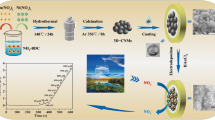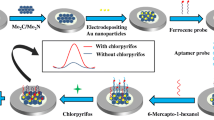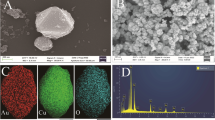Abstract
The excessive utilization of antibiotics has led to significant water contamination and posed severe threats to human well-being. Consequently, the pressing imperative to identify antibiotics in the environment arises. In this study, we have successfully synthesized a hollow PCN-222 MOF distinguished by its substantial surface area and abundant functional groups, particularly the porphyrin cores. To augment the electrical conductivity of the hollow PCN-222 (HPCN-222), gold (Au) particles were incorporated within the porphyrin core using a fundamental hydrothermal method. This modification facilitated the effective immobilization of aptamer strands through π-π stacking and electrostatic interactions. As a result, the Au@HPCN-222 composite demonstrated exceptional efficacy as a substrate for immobilizing the aptamer (Apt) onto the GCE surface. By employing differential pulse voltammetry (DPV) we successfully achieved the detection of chloramphenicol (CAP) with a remarkably low limit of detection of 0.0138 ng mL−1 and the peak DPV currents at 0.18 V (vs. Ag/AgCl) were used for calibration. Furthermore, this aptasensor exhibited high selectivity and reproducibility.
Graphical abstract








Similar content being viewed by others
Data availability
All data generated or analysed during this study are included in this published article and its supplementary file.
References
Wang M, Hu M, Liu J et al (2019) Covalent organic framework-based electrochemical aptasensors for the ultrasensitive detection of antibiotics. Biosens Bioelectron 132:8–16
Zhao YL, Chen Q, Lv J et al (2022) Specific sensing of antibiotics with metal-organic frameworks based dual sensor system. Nano Res 15:6430–6437
Wang X, Liu C, Wang M et al (2022) A selective fluorescence turn-on sensing coordination polymer for antibiotic aztreonam. Chem Commun 58:4667–4670
Sharma R, Akshath US, Raghavarao K et al (2019) Fluorescent aptaswitch for chloramphenicol detection – quantification enabled by immobilization of aptamer. Sens Actuators B 290:110–117
Ma P, Guo H, Duan N et al (2021) Label free structure-switching fluorescence polarization detection of chloramphenicol with truncated aptamer. Talanta 230:122349–122349
Kong CT, Chan LC, Ma SK et al (2000) Effects of antioxidants and a caspase inhibitor on chloramphenicol-induced toxicity of human bone marrow and HL-60 cells. Hum Exp Toxicol 19:503–510
Chen XY, Hao SB, Zong B et al (2019) Ultraselective antibiotic sensing with complementary strand DNA assisted aptamer/MoS2 field-effect transistors. Biosens Bioelectron 145:111711
Cardoso AR, Tavares A, Sales M (2018) In-situ generated molecularly imprinted material for chloramphenicol electrochemical sensing in waters down to the nanomolar level. Sens Actuators B 256:420–428
Sakthivel M, Chen SM, Ho KC et al (2018) Synthesis and characterization of samarium-substituted molybdenum diselenide and its graphene oxide nanohybrid for enhancing the selective sensing of chloramphenicol in a milk sample. ACS Appl Mater Interfaces 10:29712–29723
Xie YY, Huang Y, Tang DY et al (2018) A competitive colorimetric chloramphenicol assay based on the non-cross-linking deaggregation of gold nanoparticles coated with a polyadenine-modified aptamer. Microchim Acta 185:534
Yan JM, Li PG, Xiao HN et al (2018) The signal amplification in electrochemical detection of chloramphenicol using sulfonated polyaniline-chitosan composite as redox capacitor. Electroanalysis 30:2085–2093
Wang K, Liu CY, Zhu BC (2023) Recent advances in small-molecule fluorescent probes for diagnosis of cancer cells/tissues. Coord Chem Rev 15:214946
Pan Y, Fei DW, Liu PH et al (2021) Surface-Enhanced raman scattering–based lateral flow immunoassay for the detection of chloramphenicol antibiotics using Au@Ag nanoparticles. Food Anal Method 14:2642–2650
Xiao DF, Jie ZS, Ma ZY et al (2020) Fabrication of homogeneous waffle-like silver composite substrate for Raman determination of trace chloramphenicol. Microchim Acta 187:593–593
Zhang HL, Liu S, Yu A et al (2017) Amperometric aptasensing of chloramphenicol at a glassy carbon electrode modified with a nanocomposite consisting of graphene and silver nanoparticles. Microchim Acta 184:1445–1451
Jo H, Gu H, Jeon W et al (2015) Electrochemical aptasensor of cardiac troponin I for the early diagnosis of acute myocardial infarction. Anal Chem 87:9869–9875
Zhou Y, Qian Y, Zhang DA et al (2018) Detection and removal of antibiotic tetracycline in water with a highly stable luminescent MOF. Sens Actuators B 262:137–143
Fu R, Hu S, Wu X (2017) Rapid and sensitive detection of nitroaromatic explosives by using new 3D lanthanide phosphonates. J Mater Chem A 5:1952–1956
Zeng G, Xing S, Wang X et al (2016) 3d–4f metal–organic framework with dual luminescent centers that efficiently discriminates the isomer and homologues of small organic molecules. Inorg Chem 55:1089–1095
Han ZY, Zhang H, Li HK et al (2021) Ingenious construction of an electrochemical aptasensor based on a Au@COF/GO-NH2 composite with excellent detection performance. J Mater Chem C 9:4576–4582
Biswas S, Chen YL, Wang Y et al (2020) Ultrasmall Au(0) inserted hollow PCN-222 MOF for the high-sensitive detection of estradiol. Anal Chem 92:4566–4572
Kreno LE, Leong K, Farha OK et al (2012) Metal-organic framework materials as chemical sensors. Chem Rev 112:1105–1125
Xu Z, Meng QY, Cao Q et al (2019) Selective sensing of copper ions by mesoporous porphyrinic metal–organic framework nanoovals. Anal Chem 92:2201–2206
Shang HY, Xu H, Liu Q et al (2019) PdCu alloy nanosheets-constructed 3D flowers: new highly sensitive materials for H2S detection. Sens Actuators B 289:260–268
Biswas S, Naskar H, Pradhan S et al (2019) Sm2O3 nanorod-modified graphite paste electrode for trace level voltammetric determination of acetaminophen and ciprofloxacin. New J Chem 44:1921–1930
He T, Chen S, Ni B et al (2018) Zirconium–porphyrin-based metal–organic framework hollow nanotubes for immobilization of noble-metal single atoms. Angew Chem Int Ed 57:3493–3498
Liu KP, Zhang JJ, Wang CM, Zhu JJ (2011) Graphene-assisted dual amplification strategy for the fabrication of sensitive amperometric immunosensor. Biosens Bioelectron 26:3627–3632
Liu QY, Yang YT, Zhu RR et al (2015) NiO nanoparticles modified with 5,10,15,20-tetrakis(4-carboxylpheyl)-porphyin: promising peroxidase peroxidase mimetics for H2O2 and glucose detection. Biosens Bioelectron 64:147–153
Ahrenholtz RS, Epley CC, Morris JA (2014) Solvothermal preparation of an electrocatalytic metalloporphyrin MOF thin film and its redox hopping charge-transfer mechanism. J Am Chem Soc 136:2464–2472
Wang XX, Yang T, Li X et al (2011) Three-step electrodeposition synthesis of self-doped polyaniline nanofiber-supported flower-like Au microspheres for high-performance biosensing of DNA hybridization recognition. Biosens Bioelectron 26:2953–2959
Chinese Health Ministry, National food safety standard, determination of chloramphenicol residues in milk by liquid, GB 29688–2013
Sharma R, Akshath US, Bhatt P et al (2019) Fluorescent aptaswitch for chloramphenicol detection–Quantification enabled by immobilization of aptamer. Sens Actuators B 209:110–117
Acknowledgements
The authors gratefully acknowledge the financial support of this work by the National Natural Science Foundation of China (Grant No. 22008011 and 22108170), Project of Yulin Science and Technology Bureau (Grant No. CXY-2020-023), Shaanxi Province Postdoctoral Science Foundation (No. 2018BSHGZZHQYXMZZ27), National College Student’s Innovation and Entrepreneurship Training Program (No. S202210710261).
Author information
Authors and Affiliations
Contributions
Jiang Li: Formal analysis, Writing—review & editing, Writing—original draft. Lingli Qu: Methodology, Formal analysis, Investigation. Huitong Li: Methodology, Investigation. Lu Zhao: Validation, Formal analysis. Tongdan Chen, Jiaying Liu and Yuting Gao: Visualization, Resources. Hongzhi Pan: Review & editing.
Corresponding authors
Ethics declarations
Competing interest
The authors declare that they have no known competing financial interests or personal relationships that could have appeared to influence the work reported in this paper.
Additional information
Publisher’s note
Springer Nature remains neutral with regard to jurisdictional claims in published maps and institutional affiliations.
Supplementary Information
Below is the link to the electronic supplementary material.
Rights and permissions
Springer Nature or its licensor (e.g. a society or other partner) holds exclusive rights to this article under a publishing agreement with the author(s) or other rightsholder(s); author self-archiving of the accepted manuscript version of this article is solely governed by the terms of such publishing agreement and applicable law.
About this article
Cite this article
Li, J., Qu, L., Li, H. et al. An electrochemical aptasensor for the detection of chloramphenicol based on ultra-small Au-inserted hollow PCN-222 MOF. Microchim Acta 190, 366 (2023). https://doi.org/10.1007/s00604-023-05949-y
Received:
Accepted:
Published:
DOI: https://doi.org/10.1007/s00604-023-05949-y




